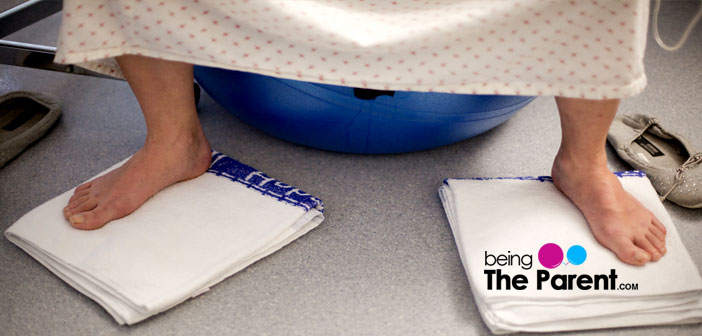
The process of labor is a complicated one as a number of events happen simultaneously and are responsible for the delivery of the baby. The passage, the passenger (baby) and the mother all are actively involved in this great natural phenomenon.
- What Is Meant By Pushing Or Bearing Down The Baby?
- How Does Pushing During Delivery Happen?
- What Are The Types Of Pushing?
- What Factors Influence The Pushing Stage During Delivery?
- How Can I Select An Appropriate Birth Position?
- Breathing Methods During Labor
- How Can I Breathe Properly During Pushing?
- When Does The Second Stage Of Labor Begin?
- Perineal Aiding Measures
What Is Meant By Pushing Or Bearing Down The Baby?
Pushing or bearing down is an important stage of labor. With the onset of uterine contractions, the cervical canal begins to dilate and the process of cervical effacement commences and the baby starts to descend down in the birth canal. Pushing or bearing down can be described as the attempt or effort by the mother in trying to push the baby out of the uterus. The mother actively bears down or pushes when she gets the uterine contractions which are intermittent. Of the three stages of labor (contraction, giving birth, afterbirth) the most significant and most alarming phase is the pushing stage.
There will be lots of images and imagination regarding this stage as most of us have viewed this scene (though partially) in most of the family movies from our childhood. In most of them, commonly the women seem to scream wildly, hold their breath, turn pale or purple during and are out of their wits. This is not so all true.
How Does Pushing During Delivery Happen?
The first thing you should do when you are getting ready for a vaginal birth is to wipe off these frightening images. Giving birth is not such a complicated process of “life or death”. Do you know that a mother in a coma stage can also give birth to a healthy baby vaginally? This is because the body and uterus know how to do their work without much contribution from the mother’s part.
When the cervical opening is fully dilated the mother might not experience any uterine contractions- this is termed as thankful or rest phase. This helps the mother to calm down and also provides time to the baby to rotate to a preferable position. Some caregivers encourage the mother to bear down during this phase too, but it is of no help either to the baby or the mother. If you are aware how to push out the baby, it will make your delivery much easier and minimize the injuries that happen during vaginal birth.
First, let’s go through some steps that you are supposed NOT to do even if you have the urge to do so. They are:
- Never hold your breath
- Never start pushing if you are not feeling the urge to push
- Never lie on the back
- Never take notice of or calculate the duration of a push
- Never let someone or something to hold back the legs
What Are The Types Of Pushing?
The types of pushing are enlisted as below:
- Laboring Down: In this type of pushing the mother allows her body to push down on its own without any efforts to accentuate the pushing down of her uterus
- Spontaneous Bearing Down: In this the mother ‘allows her body to tell when to actively push’. The mother cannot hold her breath for more than 5-6 seconds
- Purple Pushing: When the mother is asked to push down and hold breath for a count of ten, it is called purple pushing. In purple pushing the mother turns purple with bulging eyes and everybody around her shouts “PUSH”! It is done in women who do not experience any urge to bear down

What Factors Influence The Pushing Stage During Delivery?
There are three important factors which help fast and safe pushing stage. That are:
Birth Position
The selection of birth, position plays a significant role in determining the comfort level of the mother during the process of delivery. It also influences how fast and efficiently the labor progress (or does not progress). A perfect birth position can speed up the labor and diminish uneasiness as it places the child in correct position. Also, unnecessary muscular exertion is reduced when the birth position is perfect. During pushing upright position of the mother is preferred as this allows the gravity to favor the process of pushing. However a number of positions are available in nowadays birth beds such as foot pedals, squat bar, etc.
How Can I Select An Appropriate Birth Position?
There is no one best birth position that fits all. In fact, a good midwife will ask the mother to change the birth position frequently during the labor to ease the pain. The most significant point is whatever position you opt, never opt for a position that requires you to stay flat on your back. The position that may have clicked for one woman may not be a success in another one. Also, the position helped you a lot on your first pregnancy may not help you during your second pregnancy.
Here we explain some positions which could help you in different situations.
- Side-lying position:
- Mother rests on one side of her body slightly curled. Sliding a pillow between the knees can increase the comfort level
- Suitable for slow and controlled birth
- This position reduces unnecessary muscular exertion thereby lessening the fatigue in a long labor
- This position will avoid the compression of major blood vessels(which may occur when you stay flat on your back)
- However, during the early labor, this position is not found to the best choice
- Hands and knees:
- Mother gets on all four on the bed
- This position is apt when the baby is big or during a posterior presentation
- Being on the hand and knees will provide relief from back pain prior to and during the labor
- Rocking:
- Rocking back and forth in rhythm with the breathing (with or without playing the music in the back ground) can be soothing during the labor
- This can also emotionally support the mother if she puts her arms around the birth companion’s (most of the time husbands) neck during rocking
- Walking:
- Walking during the early stage of the labor can provide some distraction for the mother especially during slowly progressing labor
- Just remember to seek some extra support when you get into the active labor
- Crawling position:
- This position is carried out as absolutely as it sounds
- This position favors when umbilical cord prolapse is an issue
- If the amniotic sac breaks and the cord fell into the birth canal, this position will prevent the cord from falling further
- Full moon position:
- In this position, you rest your shoulders and forearms on the level surface, keeping your front part lower than the rear
- This position suits to turn a posterior baby
- All the upright positions will utilize gravity to stimulate the progression of the labor
Breathing Methods During Labor
Breathing correctly while pushing will allow the baby move slowly down in a controlled fashion. Holding the breath will worsen the pain. As holding breath hinders with your oxygen intake, it can also make your child deprive of the oxygen. The patterned breathing will:
- Allow the tissues to stretch slowly minimizing the risk of tearing
- “The ring of fire” which often occurs when the baby crowns, can be avoided if you breath properly
- Makes the contraction more productive

How Can I Breathe Properly During Pushing?
- At the beginning and end of each contraction take a deep relaxing breath. This will provide more oxygen for your baby
- Variable breathing can be tried in the first stage when you are unable to relax. This breathing is also referred as “hee-hee-hoo” breathing. It consists of two or three light shallow breaths followed by a longer exhalation (like the name)
- Start to breathe slow when the contractions are intense
- Keep the mouth open. Keeping the throat and jaw relaxed is important as the jaw is tense, so is your perineum (sphincter law)
- Slowly breathe in through your nose and breathe out through your mouth, allowing the air flow out with a sigh
- During the active labor, breathe in and breathe out rapidly through the mouth at about one breath per second
- As the contraction reaches the peak level, lightly breathe in and breathe out through your mouth
- As the contraction decreases, slow down the breathing rate and switch back to breathe in through your nose and breathe out through your mouth
When Does The Second Stage Of Labor Begin?
When the cervix is fully dilated, the second stage of labor begins:
- Focus on the baby’s movement. Breathe slowly. You can speed up or slow down your breathe according to your comfort. When you have an irresistible urge to push, lean forward, tucking your chin to your chest slightly holding and slowly releasing breath by moaning
- After 4-5 seconds, release your breath and start to breath in and breath out
- Repeat this whenever you feel the urge to push (pushing urge comes and goes in waves). Utilize the breaks to breathe deeply which provides enough oxygen for the mother and child
Another tip is to wait for the body signal to start pushing rather than starting to push before the real urge begins. The fact that you are dilated 10 cm alone does not mean that you should start pushing.
Perineal Aiding Measures
A good perineal support can eliminate or diminish the chances of tearing. Perineal massages during the early stage of pregnancy will help to prepare the perineal tissues for the delivery. Your bystander or mid wife can:
- Apply warm compressors directly to perineum as the vagina starts to bulge when the baby starts descending
- Supporting the perennial tissue and emerging head of the baby will help with a slow and controlled delivery minimizing the tearing
- Avoid episiotomy as long as possible. Discuss this wish with your practitioner during prenatal appointments. Tearing, even the worst one, heals better than an episiotomy. This is because tearing effect only the soft tissue, whereas an episiotomy slice through the skin and muscle layer
Even after keeping all the above points in mind, if you feel an overwhelming urge to push, it is your body’s way to tell you that the baby is coming. If there are no other complications (like cord compression and fetal distress), go ahead with your urge.
